► Ford Transit Custom vs rivals
► Forget your SUV – your active life needs a van
► So, which one out of these four is best?
So you don’t want mud on that cream leather interior? Then forget your luxury SUV – for real sports and utility in 2024, you need a van. Ford’s latest Transit Custom take on VW’s upstart ID. Buzz Cargo, the Vauxhall Vivaro and Toyota Proace to nail exactly what is best for your active life.
Pre-flight briefing: Ford Transit Custom
Why is it here?
As Britain’s best selling vehicle, the arrival of a completely new Ford Transit Custom is big news, and not only for heating engineers. The Custom is such a flexible, ubiquitous vehicle on our roads – from camper conversions to school minibuses – it touches the lives of a lot of people, and will find fresh uses with subsequent owners.
Any clever stuff?
The interior of the new Custom has been cleverly thought through. Examples include moving the passenger airbag into the roof, making way for a huge second glovebox in the dash; plus the Mobile Office pack includes a 5G modem and a tilting steering wheel for when you’re parked to eat your lunch – already nicknamed the Transit Table.
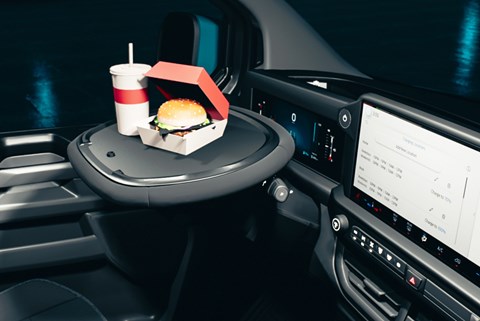
Which version is this?
The new Custom van will soon be available with different lengths and rooflines, and with hybrid and full battery powertrains, though at the time of writing only the long-wheelbase, low-cab, 2.0-litre diesel is on UK roads. Choices start with the 108bhp Leader – ours is the 148bhp Limited. (You can see why Ford milks the Transit name, but it does make for a confusing line-up: Transit Courier, Transit Connect, the non-Custom version of the Transit, and E-Transit all co-exist.)
Read our Ford Transis Custom
Pre-flight briefing: VW ID. Buzz Cargo
Why is it here?
The Buzz is a van that crosses over from the commercial world into the realms of everyday car enthusiasm. Next to the passenger Buzz, it does look like a commercial vehicle, but next to other commercial vehicles it looks like a lifestyle accessory. It’s not as big as the others here – and at £50k, most builders would laugh at the thought of buying one – but for boutique businesses or as a leisure van, it’s very appealing.
Any clever stuff?
Based on VW’s modular MEB platform, it’s a clever skateboard chassis under the floor. Unlike some more powerful ID products, it keeps things simple, with one motor and rear-wheel drive. There’s a modern minimalism to the Cargo, making it easy to live with. We like the huge rear hatch, rather than the usual van-style barn doors – great when you get caught out in the rain.
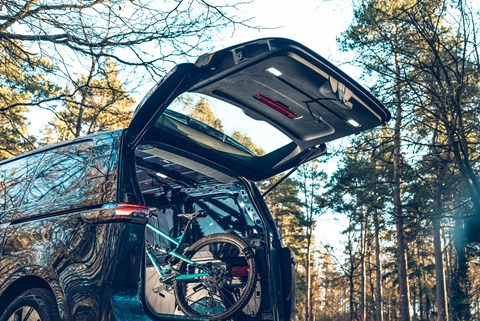
Which version is this?
There aren’t lots of wheelbase and roofline options with the Cargo, just one model with one battery (77kWh), in two trim levels: Cargo Commerce from £48,541, or our Commerce Plus (£53,641), which includes the Discover Pro nav system and LED lights.
Read our VW ID. Buzz Cargo review
Pre-flight briefing: Vauxhall Vivaro
Why is it here?
The Vivaro represents the Stellantis group, so we could have had a Fiat, Peugeot or Citroën – apart from different grille and headlights, they’re all the same hardware. However, after the huge-selling Transit, it’s the Vauxhall Vivaro that’s Britain’s second best-selling van – and if you take the time to notice, you’ll see them everywhere.
Any clever stuff?
Our Vivaro Electric GS is fully electric, so there’s plenty of high-tech stuff going on under the skin, including a single motor driving the front wheels and regenerative braking system; standard among EVs, but quite a departure if you’ve spent decades driving diesel Transits. More noticeable on the surface is the GS bodykit, which includes front and rear spoilers, 18-inch alloy wheels and a go-faster rear wing.
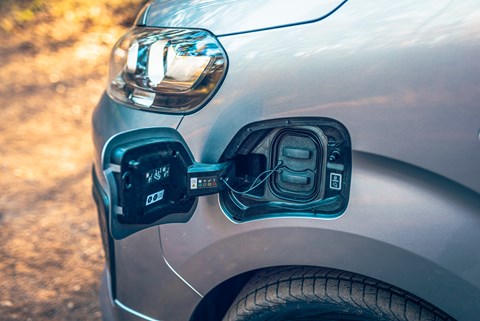
Which version is this?
The Vivaro is available in lots of configurations, and the electric version comes with two battery options, a 50kWh and 75kWh. Ours is the bigger battery and in GS trim, so it has the sporty exterior, decent air conditioning – again, not traditionally a given in van circles – and a leather interior. The electric version costs a lot more than a diesel, and the trim adds a lot more too, so buy wisely.
Pre-flight briefing: Toyota Proace
Why is it here?
If you don’t want a Transit, chances are you’ll be looking at a van from the Stellantis/Toyota tie-up, which saw the development of the Citroën/Peugeot/Fiat/Vauxhall/Toyota vans, in a remarkable bit of intra- and inter-company cooperation, and/or an acknowledgement that the Ford is very hard to beat. They’re all mechanically identical, though the Toyota doesn’t offer an EV version, instead focusing on mainstream diesel options.
Any clever stuff?
It comes with keyless entry, parking sensors and a seven-inch colour touchscreen. One clever idea is the Smart Cargo system, which uses a bulkhead hatch and a lifting front passenger seat to increase the load length by 1.1 metres.

Which version is this?
The Proace comes with a short or long wheelbase and as a panel van or a crew cab. The entry level Active trim starts at £36,175, but ours is a Design spec with 17-inch alloys. A 1.5-litre is available but our example is fitted with the 2.0-litre diesel engine married to an eight-speed automatic gearbox. Except since this test was done, Toyota has withdrawn the combination of Design trim and 174bhp engine. Design is now only offered with the 138bhp engine, at £2k less than our test van.
Transit vs Buzz Cargo vs Vivaro vs Proace: loads of fun
A couple of years ago, a young family friend left the UK, looking for adventure. He travelled to Canada, bought a van and now his Instagram feed is nauseatingly idyllic: ‘Ooh, here I am waking up in the Rocky Mountains! Now a view of Banff National Park out the back doors! #vanfluencer #vanlife #iammoreinterestingthanyou.’
Scrolling through his images makes me realise two things: first, I made some poor life choices; second, vans are not what they used to be. Traditionally, vans were white and full of tools and they were the noble workhorses for plumbers and electricians the length and breadth of Britain, and indeed many other countries. Now that’s changed: visit your local forest car park on a Sunday morning, for example, and the cyclists aren’t unloading their mountain bikes out of Range Rovers and XC90s. Instead, they’re in vans and hauling around lifestyle dreams like the British-built Cotic bikes in the pictures (an on-trend brand with lower carbon steel-framed bikes and a focus on recycling that even extends to re-using cable ties): driving them, sleeping in them, hash-tagging about them.
The wider population has come to appreciate the qualities of these cargo-carrying boxes: vans are sporty and utilitarian, the ‘SUV’ for a new generation. Yes, they’re usually front-wheel-drive not 4×4, but vans are roomy by design, down to earth, cheap to run and they offer a driving position any emperor would approve of – high up, three abreast, cupholders galore.
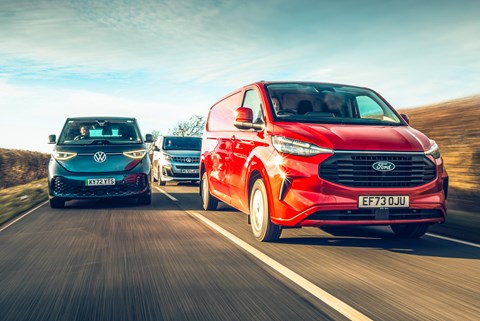
But the vans themselves are also changing. Gone are the days of your base-spec panel wagon, only available in white with AM radio. Now you can pimp them up, adding alloys, metallic paint and electric powertrains.
The van-daddy of them all, of course, is the Ford Transit, first launched in 1965. It has since gone through eight or nine generations (Transit history is hotly disputed) and in 2012 the range was split between the bigger Transit and the more compact Transit Custom. The Custom has been a huge hit – it was Britain’s outright best-selling vehicle in 2021 and 2022, beating all your Qashqais and Corsas, with around 50,000 units sold. In 2023 it was still in the top three, selling over 40,000, and that’s the outgoing model. Because now a new Transit Custom has arrived, redesigned from the ground up.
The new Ford has many competitors, several of which are actually the same van in disguise. The Vauxhall Vivaro, Fiat Scudo, Peugeot Expert and Citroën Dispatch are all identical beneath those Stellantis group badges, and even the Toyota Proace is actually the same van, built under licence in France. Alongside these traditional players, the lifestyle end of the market is also hotting up with the arrival of the ID. Buzz Cargo, the van version of Volkswagen’s all-electric Kombi rebirth.
Our Transit Custom is a long-wheelbase with a 2.0-litre diesel – the only model available at launch, though hybrids and fully electric versions are coming soon. Ours has optional metallic paint (£650), which pushes the price closer to £50k. (Note that the prices we’re using are with VAT, which may not apply if your van is a legit business use.)
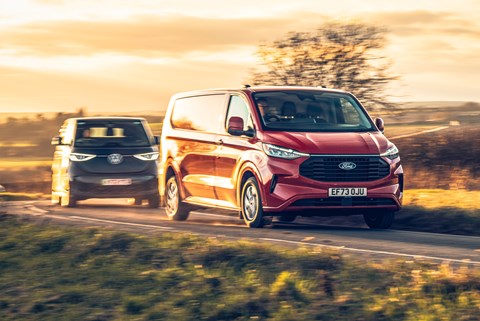
If you think that’s expensive, get a load of our gorgeous ID. Buzz Cargo. It’s a fully loaded Plus model with a base price of £53,641, bumped up by things like optional paint and matrix LED lights to an eye-watering £56,978 on the road. Little wonder most Cargos you see on the road belong to upmarket boutique shops, not drain specialists or rodent exterminators.
Representing the Stellantis vans we have the battery-powered Vauxhall Vivaro Electric in sporty GS trim, meaning you get leather seats, racy-looking front and rear spoilers and 18-inch alloy wheels. With a £650 metallic paint option, it costs over £63k on the road. We also have a Toyota Proace in Design trim. It’s directly related to the Vauxhall, but not electric: this van has a 178bhp 2.0-litre diesel and eight-speed auto gearbox and like the Transit it’s priced in the 40s.
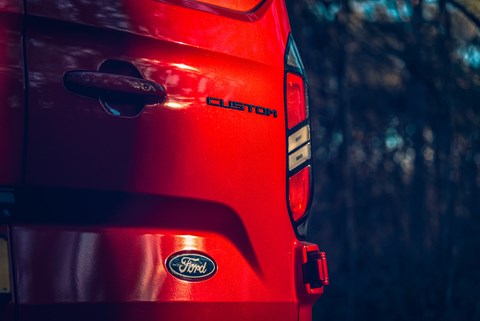
Gathering early one morning it’s the Transit, finished in bright Artisan Red, that really pops in the wintry sunlight. With its sleek headlights and angular grille, the new Custom looks fresh and modern. Bearing in mind that this is no mild-facelift nose-job, but a completely new platform, it’s visually perhaps a little disappointing – while the wheelbase has been stretched by 200mm and the whole thing lightened by 100kg, it’s hardly a wild, futuristic re-imagining. Still, why mess with Britain’s best-selling vehicle? No one’s going to get fired for this cautious evolution.
The generational shift is more noticeable when you step up into the cabin: the dash, dominated by a 13-inch touchscreen in the centre with a smaller screen in the binnacle, looks bang up-to-date, and regular Custom owners will also notice the floor space beneath that middle seat is now completely flat.
But don’t look down at the floor! Look up, at the magnificent view! Though Ford has maintained the compact dimensions of the Custom (in particular, the roof has been lowered to just under two metres so it’ll fit into car parks) the new van still enjoys a commanding driving position, and the huge glasswork gives you the forward visibility of a helicopter bubble.

After a keyless start, you soon find the Transit is as orthodox to drive as it is to look at, its trusty engine and six-speed gearbox carried over from the outgoing model. There are three diesel power outputs available, ranging from 108bhp to 168bhp depending on whether you go manual or automatic. Ours is the 148bhp version, and there’s something appealing about its straightforward, get-in-and-go character. The new steering is light but accurate and direct, and the chunky, squared-off steering wheel feels very positive and reassuring in your hands.
In no time you’re bombing along with the traffic, feeling like the King of the Road. As well as fun, the new Custom also feels refined, and with new independent suspension at the rear it rides well. Comfortable, quick enough, and with all the new infotainment screens and connectivity on board, driving around in it for a day is a much more car-like experience.
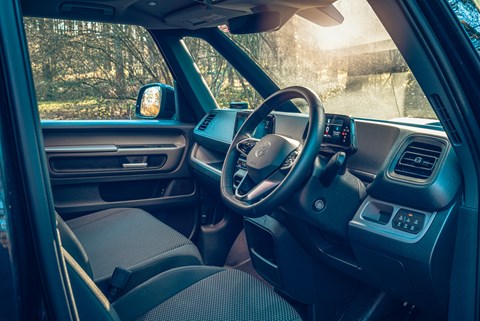
Looping back to our base in the forest, I park up next to the ID. Buzz and stare at it, lovingly. For maximum contrast I’m going to jump straight out of the new-but-traditional Ford into the bold electric Volkswagen; but before I do, it’s worth acknowledging that in many ways these two aren’t direct competitors. For starters, our Custom is the long-wheelbase version with 6.8 cubic metres of loadspace, whereas the Buzz has just 3.9 cubic metres; and while the diesel Transit can hammer up the A1 all day long, between quick diesel and Haribo refills, the electric Buzz – with its 77kWh battery – has a WLTP range of 252 miles. In reality, that means a couple of hundred miles before it’s time to stop for a relaxing cup of tea and recharge. The Buzz is capable of rapid charging at 170kW, so a 30-minute charge can take the battery from five to 80 per cent, but still, it’s little wonder that battery power accounts for only around six per cent of the UK van market. They might work for local deliveries, but when you’re travelling further afield, time is money.
Yet in the wider lifestyle van market the Buzz Cargo is still a contender, simply because it’s so adorable. At 4.7 metres long, it’s around 70cm shorter than the LWB Transit Custom and the roofline is 30cm lower too. Sitting on those big 19-inch alloys, the robot-breadloaf Buzz looks like it’s driven straight from concept-car sketchbook onto the road. Inside, the overall architecture is as distinctive as the exterior. Like the Transit, there’s a big screen in the middle of the dash and another acting as the instrument binnacle, but the whole layout feels much more linear and stylish than the Ford.

And while the other vans have a semblance of a sloped windscreen and bonnet, the blunt nose of the Buzz Cargo was created by moving the screen to the very front. Climb in, and there’s a weird, boxy glasshouse ahead of the dashboard, giving the cockpit an ambience that’s unlike anything else on the road.
That interior vibe informs a lot about the driving experience. With a 201bhp motor driving the rear wheels, it feels swift but it’s no hardcore drift machine; it’s relaxed and quiet, but like all EVs it lacks emotion. The ride is very car-like, if a bit choppy at times. So no single element of the Buzz really stands out as exceptional; however, none of this matters, because sitting there, at the blunt end of this cute little box, you’re always conscious of what you’re driving, and that’s enough to put a smile on your face.
Which is why, altogether, it was a little unfair to climb straight out of the Buzz and into the electric Vauxhall Vivaro.
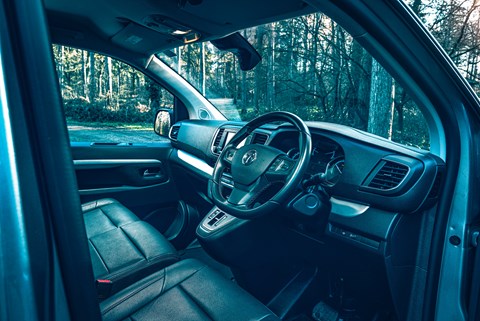
Viewed on its own, the Vauxhall is actually quite a handsome machine, and Stellantis has done a good job of hiding the 75kWh battery under the loadbay floor; there’s a 50kWh battery option too. And on nearly every practical metric, the Vivaro beats the Buzz, which explains why it was the best-selling electric van of 2023, taking almost 30 per cent of that market. Payload volume is 5.8 cubic metres (the Buzz is just 3.9, remember) and the maximum load weight is 1000kg, compared to the VW’s 592kg.
So it should be a no-brainer – the Vivaro makes more sense – but it’s not. That stiff price is partly to blame, making the ⊲ Vauxhall more expensive than the Buzz; yet compared to the head-turning Volkswagen the Vivaro feels bland. And that’s despite the bodykit, despite the 18-inch alloys, despite some coloured dials and bits of alloy trim jazzing up the interior. The Vivaro simply lacks the raw, irrational appeal of the Buzz.
The Vivaro also falls short behind the wheel: with 134bhp and that instant electric torque it feels quick enough when you pull out of a junction, but that bravado soon dims as the speed increases. Vauxhall claims the Vivaro Electric will do 0-62mph in 14.3 seconds, a whole four seconds slower than the Buzz. Steering feel is also poor, with almost four turns lock to lock, meaning that vital first quarter-turn of movement feels vague. The official range, at 189 miles, is disappointing too.
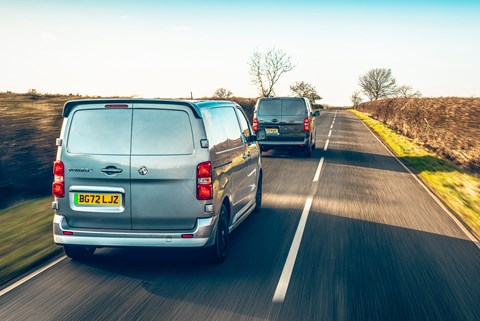
So I don’t linger in the electric Vivaro and soon I’m climbing into the Proace with pretty low expectations. These two are the same van, remember, but this Toyota is fitted with a 2.0-litre diesel. Sure enough, as soon as you get going, the Proace has that same workhorse feel as the Transit – the engine is maybe a bit louder than the Ford’s, but it also feels quick and robust, reaching 62mph in 8.5 seconds. It’s less premium than the new Transit – the dash feels out of date and the plastics are shiny, especially on the floor. Like the Vivaro, the Toyota also suffers from that classic van driving-position problem – you want to lean the seat back but it hits the rear bulkhead, so you scooch the seat forward to make more room for the back to tilt but now your legs are crunched. The new Transit is much better here.
Still, the relatively simple-spec Toyota has that crazy rental-van verve to it, unlike the electric Vivaro. With its engine drumming, it’s the kind of vehicle you drive flat-out everywhere. Despite having the same slow steering response as the Vauxhall, and an eight-speed auto ’box rather than a manual, the Toyota has no pretensions, and I liked it.
Still, get out of the Toyota and back into the Transit Custom, and you immediately feel the quality of the new Ford compared to the Stellantis vans. The Transit is more refined but also more fun to drive. Like the Proace, the Transit is a van you can really punt along a back road, with a feel and predictability that will soon have you tipping it into corners, the dog and those expensive mountain bikes flailing around the back like they’re in a tumble dryer.
Transit vs Buzz Cargo vs Vivaro vs Proace: the final reckoning
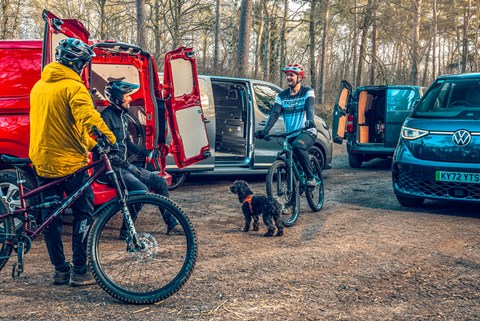
With a wide price range and such a variety of powertrains, in truth these vans probably won’t find themselves on the same shopping list any time soon. The ID. Buzz Cargo, in particular, feels like a vehicle that you’re just going to decide you want, no matter what the alternatives, and I’m sure few Buzz buyers compare loadbay lengths with a diesel Proace before they commit. The electric Cargo is smaller than its competitors, yes, but it’s still much more practical than any passenger car or SUV, and as long as your journeys are short, the powertrain is smooth and enjoyable. It has an appeal that goes beyond the traditional van market, reaching those, like me, who like anything on four wheels. Of the four vans on our test, the Buzz Cargo is the one I most wanted to drive home at the end of the day.
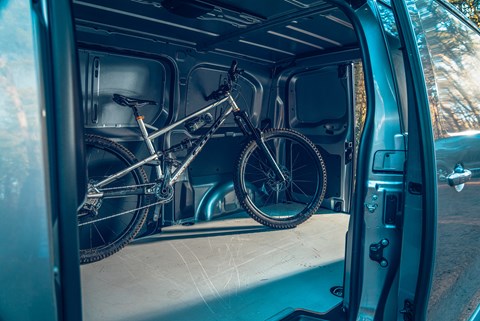
But that doesn’t mean it’s the winner. Given that the new Ford is way cheaper and offers much more loadspace than the Volkswagen, the Transit Custom is the van that really feels 100 per cent van, no pretensions or limitations – and it’s so good at being a van!
So while it might not scream ‘lifestyle choice!’ like the Buzz, the Transit is the one I can most easily imagine using as an Instagram escape, the one you’d use to run away from daily life. Rugged, unfussy, good to drive, huge in the back and a pleasure to sit in up front, the Transit Custom is a van that can do anything.
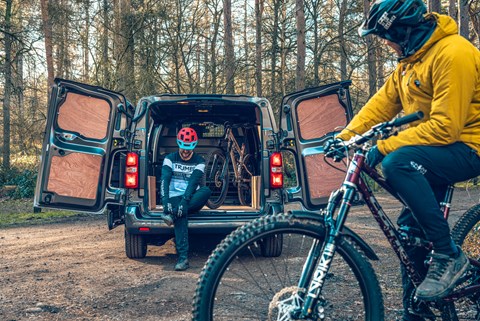
Which leaves the Stellantis pair bringing up the rear. Of the two, I actually prefer the honesty and relative simplicity of the Toyota. This isn’t really a vote against the Vauxhall – you can easily order a base-spec diesel Vivaro and it would feel just like our Proace. No, in this test, it’s more about the familiarity, practicality and cost of the diesel vs the electric version. Plus, I’m not a fan of the GS styling, though I guess that’s a matter of taste.
So the new Transit Custom wins, because no matter whether you want to transport plasterboard, or move your mountain bikes, or sleep in the back as you tour the national parks of Canada, the Custom feels like it can do anything, everywhere, all of the time. No wonder they sell gazillions of them.
Thanks to Cotic Cycles – cotic.co.uk
Transit vs Buzz Cargo vs Vivaro vs Proace: the verdict
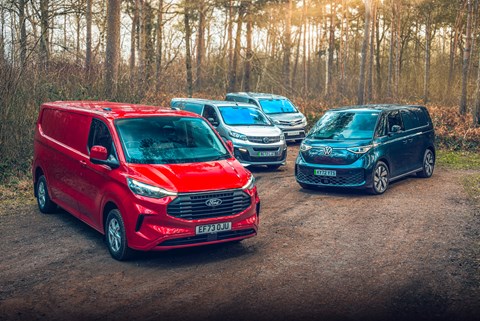
First place
Ford Transit Custom
Good for working, moving and escaping
Second place
VW ID. Buzz Cargo
Highly desirable, but costly and irrational
Third place
Toyota Proace
Practical, but boring cabin, slow steering
Fourth place
Vauxhall Vivaro
Expensive and range-limited